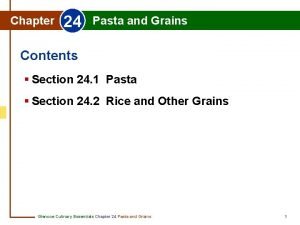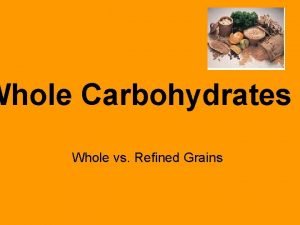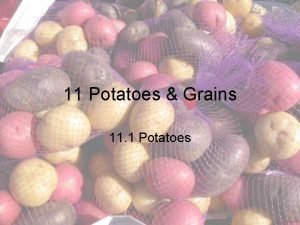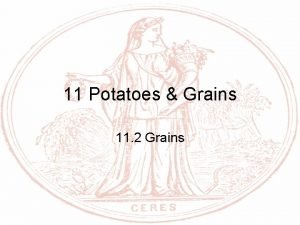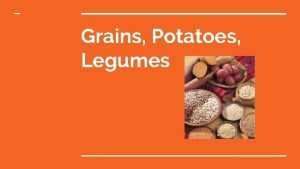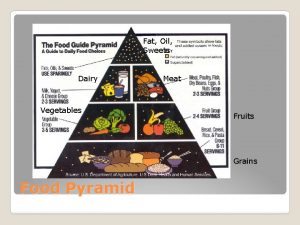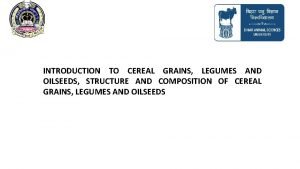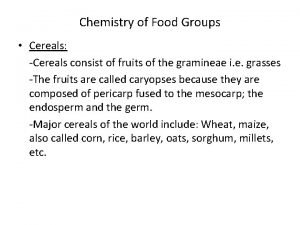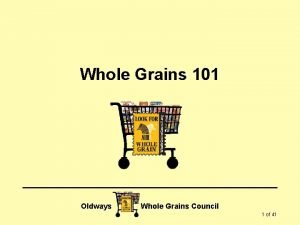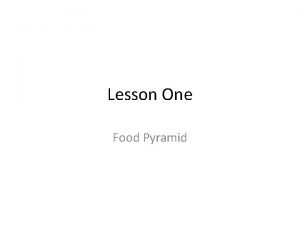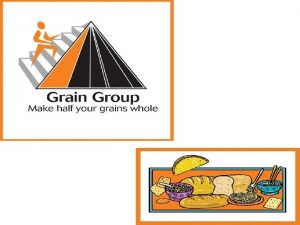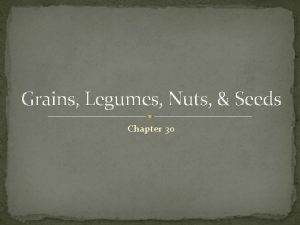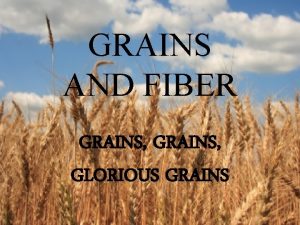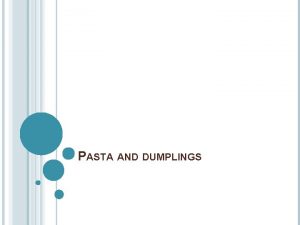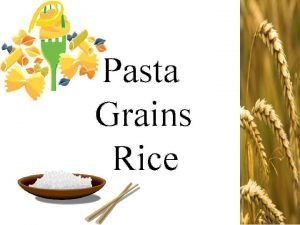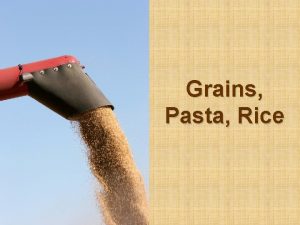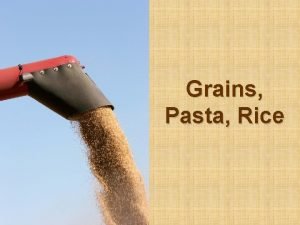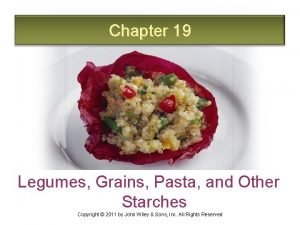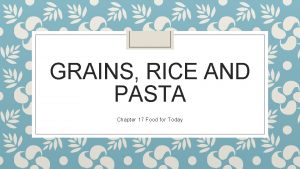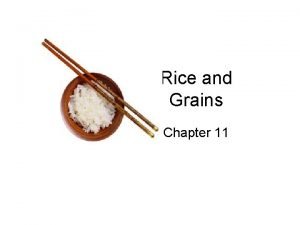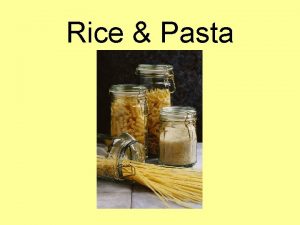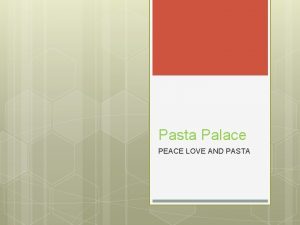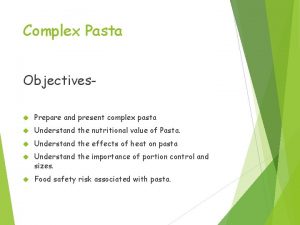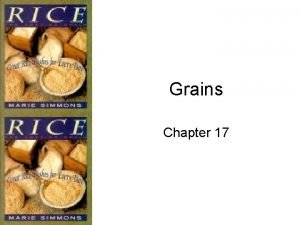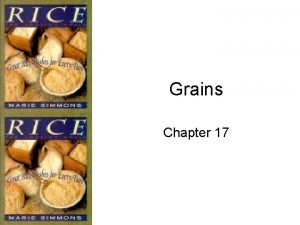Chapter 24 Pasta and Grains Section 24 1



















- Slides: 19

Chapter 24 Pasta and Grains Section 24. 1 Pasta • Pasta is a staple in commercial kitchens and is a popular menu choice. • To prepare pasta successfully, you must become familiar with the different varieties of pasta. Glencoe Culinary Essentials Chapter 24 Pasta and Grains 1

Chapter 24 Pasta and Grains Types of Pasta • Pasta is a popular menu item that comes in a variety of sizes, shapes, colors, and flavors. pasta A starchy food product that is made from grains. Glencoe Culinary Essentials Chapter 24 Pasta and Grains 2

Chapter 24 Pasta and Grains Types of Pasta • One of the main ingredients in pasta is usually semolina flour. • Other main ingredients are a liquid and sometimes an oil. semolina flour A hard-grain wheat flour that is high in the proteins that form gluten. Glencoe Culinary Essentials Chapter 24 Pasta and Grains 3

Chapter 24 Pasta and Grains Types of Pasta • Dry pasta should contain 100% semolina flour and should be hard and brittle. • Dried pasta can be stored in a cool, dry place for several months, and fresh pasta must be tightly wrapped and kept refrigerated. Glencoe Culinary Essentials Chapter 24 Pasta and Grains 4

Chapter 24 Pasta and Grains Cooking Pasta • Baking and Boiling Pasta: • Both fresh and dried pasta can be boiled or baked. • When baking pasta with a filling and a sauce or just a sauce, the flavors will blend together. • Pasta should be partially cooked before baking for most recipes. What pasta dishes have you made? Glencoe Culinary Essentials Chapter 24 Pasta and Grains 5

Chapter 24 Pasta and Grains Cooking Pasta • Determining Doneness: • Each type of pasta has a different cooking time. • When you cook pasta Italian-style, cook it to al dente “To the bite, ” meaning that the pasta is tender, but still firm. Glencoe Culinary Essentials Chapter 24 Pasta and Grains 6

Chapter 24 Pasta and Grains Cooking Pasta • Determining Doneness: • Check for doneness by biting into a piece or looking for a white ring. Glencoe Culinary Essentials Chapter 24 Pasta and Grains 7

Chapter 24 Pasta and Grains Cooking Pasta • Some pasta can be stuffed once cooked or precooked, such as tubular pasta and raviolis. Glencoe Culinary Essentials Chapter 24 Pasta and Grains 8

Chapter 24 Pasta and Grains Serving Pasta • It is important to plate and serve pasta immediately after cooking. • Some pasta dishes are served in a soup plate A shallow bowl-shaped plate. Glencoe Culinary Essentials Chapter 24 Pasta and Grains 9

Chapter 24 Pasta and Grains Section 24. 2 Rice and Other Grains • Grains have a high nutritional value and can be dried for storage for long periods of time. • This makes grains a popular diet staple. Glencoe Culinary Essentials Chapter 24 Pasta and Grains 10

Chapter 24 Pasta and Grains Types of Rice • Grains are a staple in diets around the world: • have a high nutritional value • store well grain A single, small, hard seed. Glencoe Culinary Essentials Chapter 24 Pasta and Grains 11

Chapter 24 Pasta and Grains Types of Rice • All three types of rice can be processed. • Processing involves removing the hull from the grain. • If the grain is polished, it will be white. Glencoe Culinary Essentials Chapter 24 Pasta and Grains 12

Chapter 24 Pasta and Grains Types of Rice Describe each variety of rice. Rice Variety Description Brown Rice Has had the hull removed, but is unpolished; has a tan color, chewy texture, and slightly nutty taste White Rice Has had the outer layers of the grain removed; cooks more quickly and with less water; lower in vitamins and minerals Converted Rice Has been partially cooked with steam and then dried; higher nutritional value than standard white rice Specialty Rice that has different textures and flavors, including red rice and wild rice (actually a wild water grass seed) Glencoe Culinary Essentials Chapter 24 Pasta and Grains 13

Chapter 24 Pasta and Grains Types of Rice • Storing uncooked rice: Store in airtight containers at room temperature in a dry, dark room. • Storing cooked rice: Refrigerate unused rice, but use as soon as possible as it can spoil easily. Glencoe Culinary Essentials Chapter 24 Pasta and Grains 14

Chapter 24 Pasta and Grains Other Grians • Many other grains provide nutrition and variety to menus. • Grains can be used from breakfast to dinner. Glencoe Culinary Essentials Chapter 24 Pasta and Grains 15

Chapter 24 Pasta and Grains Other Grains oats • Types of grains include: • oats • wheat • barley • kasha • quinoa • triticale Glencoe Culinary Essentials Chapter 24 Pasta and Grains The berries of oat grass. wheat A very versatile grain that is also milled into semolina and cracked wheat. barley A hardy, adaptable grain that can grow in both warm and cold climates. 16

Chapter 24 Pasta and Grains Other Grains • Corn is different from other grains because it can be eaten fresh. • Corn products include polenta and hominy. corn A grain that can be eaten fresh or as a dried grain. Glencoe Culinary Essentials Chapter 24 Pasta and Grains 17

Chapter 24 Pasta and Grains Cooking Rice and Other Grains • When cooking rice and grains, add enough water to make the grain moist and tender. • Rice can be boiled, steamed, and braised. Glencoe Culinary Essentials Chapter 24 Pasta and Grains 18

Chapter 24 Pasta and Grains Cooking Rice and Other Grains • All grains should be served as soon as possible after being cooked. • Cool, label, date and refrigerate in an airtight container any grains not used after cooking. How have you cooked rice and other grains before? Glencoe Culinary Essentials Chapter 24 Pasta and Grains 19
 Chapter 24 pasta and grains answers
Chapter 24 pasta and grains answers Refined grain bread
Refined grain bread Chapter 11 potatoes and grains
Chapter 11 potatoes and grains Chapter 11 potatoes and grains
Chapter 11 potatoes and grains Ahrbore
Ahrbore Are potatoes legumes
Are potatoes legumes Dairy meat fruits vegetables and grains
Dairy meat fruits vegetables and grains Structure of cereals
Structure of cereals Chemical food groups
Chemical food groups Dairy meat fruits vegetables and grains
Dairy meat fruits vegetables and grains Pasta, passion and pistols who did it
Pasta, passion and pistols who did it What macromolecules are in bread olive oil and pasta
What macromolecules are in bread olive oil and pasta Whole grain council
Whole grain council Grains webquest
Grains webquest Angular grains
Angular grains Name
Name Little grains of sand make the mighty ocean
Little grains of sand make the mighty ocean Food pyramid questions
Food pyramid questions One serving of grains
One serving of grains What are grains
What are grains
